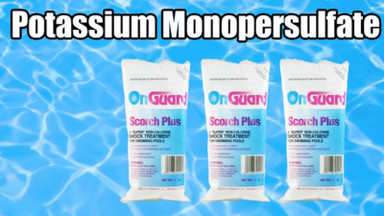All Shock Is Not Created Equal - Part 4: Monopersulfate
Published by EZ Pool & Spa Supply on 05/16/2017
Posted in: Monopersulfate, pool shock
This is the last article in a series discussing the different types of shock available and their multiple uses. In this week’s installment I’d like to address the last of the common shock alternatives available today to the pool and spa owner – namely monopersulfate. It’s often listed under active ingredients as potassium peroxymonopersulfate. Monopersulfate is a non-chlorine shock alternative that has gained some popularity over the years. It comes in granular (powder) form and can be added directly to the water.
Although monopersulfate is effective at burning off chloramines in a chlorine system, it is a weak oxidizer especially compared to chlorine shock. Chloramines (also called combined chlorine) are simply chlorine molecules combined with organic material that have lost most of their effectiveness as a sanitizer and need to be burned off. This product will not kill algae or disinfect the water.
For those rare occasions where chloramine levels are high but you do not wish to spike the overall chlorine level, monopersulfate will effectively aid in burning off the foul smelling chloramines while decreasing the chances of irritating skin or eyes due to excessive chlorine levels. So if you have a pool party in a few hours and your chloramine levels are high, monopersulfate shock is a good choice.
Monopersulfate is also a good choice when switching from one type of sanitizer to another – for example, you’ve been using biguanide (often sold under trade name Baquacil™) and wish to convert to chlorine, or vice versa. Some chemicals are incompatible (like chlorine and Baquacil™) and should not be used simultaneously. Monopersulfate is compatible with most sanitizers and works well as a temporary solution until one sanitizer is completely burned off, before switching to the next. (If switching sanitizers in a spa, most people find it best simply to empty the tub and start with fresh water.)



